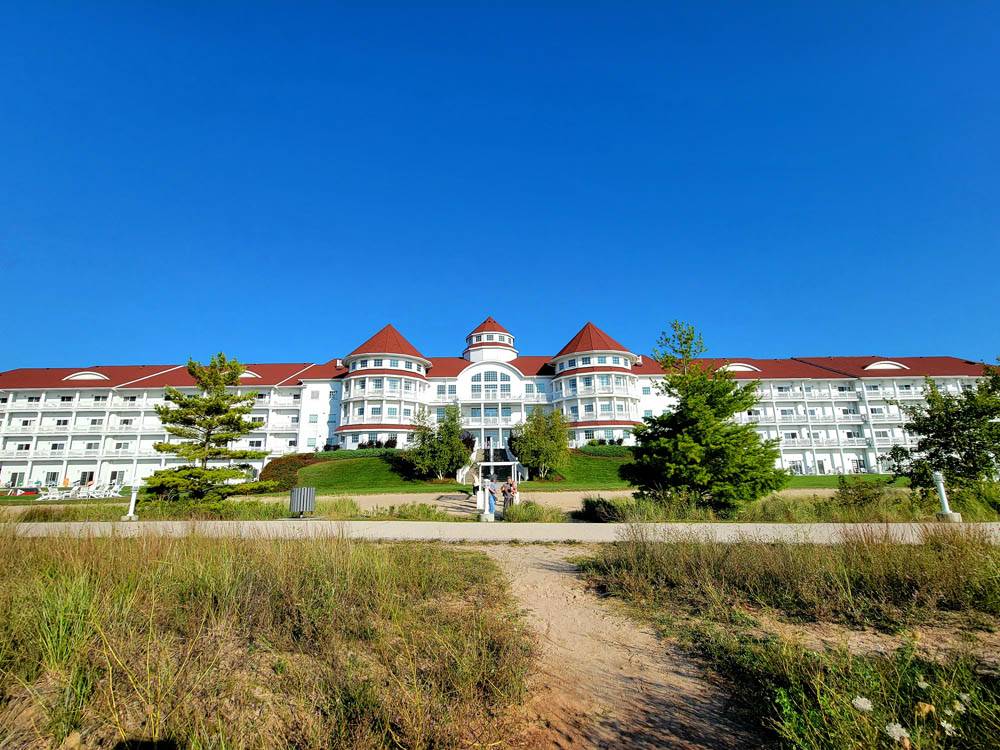I’d been in Sheboygan for less than 24 hours when I saw the t-shirt: “Sheboygan. Who knew?” it asked.
I certainly didn’t.
I had an idea I would like it. It’s called the Malibu of the Midwest, after all, and while I’m not a surfer, put me near water, especially water that laps a shoreline, and I’m a happy woman. But other than beaches and the fact that my friend Lori loves it, I didn’t know what to expect.
I arrived ignorant of the city’s many charms, and 48 hours later I wanted to live there.
Why did Sheboygan enchant me so? Arts, dining, history, outdoor fun, THE BEACH, community, pride – there’s so much wrapped up in this lakeside surprise.
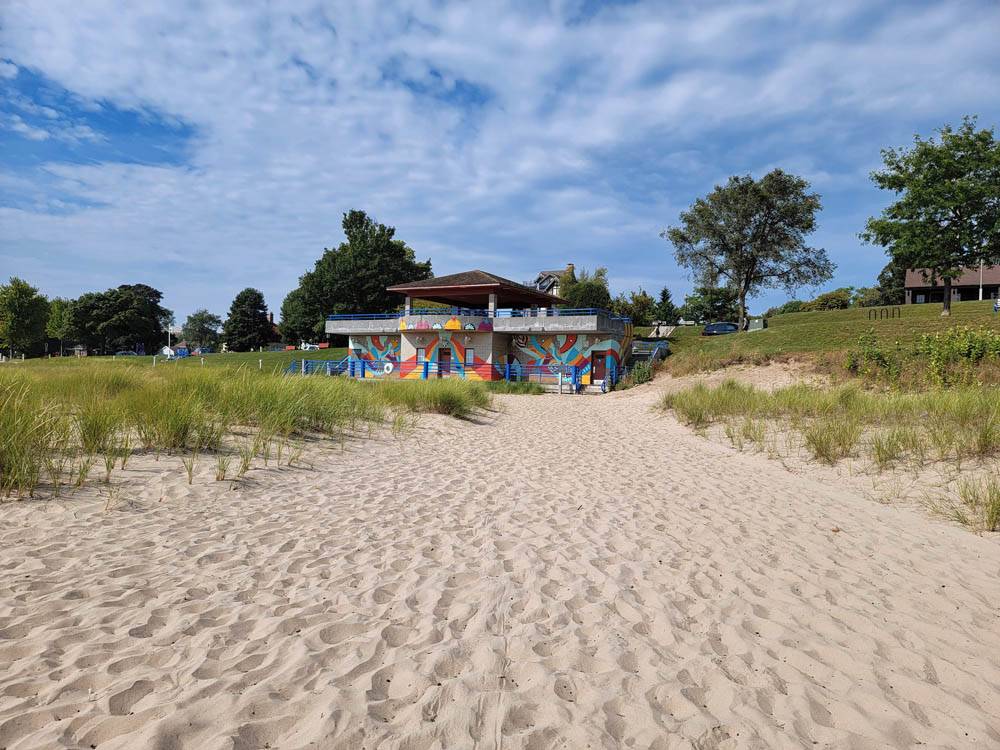
Part of the reason I wasn’t sure what to expect was because it had been a while since I’d been on a press trip. While I had explored Elgin, Illinois, a couple of weeks prior, I’m a former resident and am very familiar with the area.
The only other destination visit I’d done since pre-pandemic and pre-cancer was the writing workshop I taught in Gulf Shores, Alabama, in March. I felt a little rusty. Did I even know how to do this anymore?
I needn’t have worried. I thrive on learning as much as I possibly can about a place, having new experiences, and documenting everything so I can say to you, “Hey, you should do this.”
When it comes to Sheboygan, you should definitely do this. Do all of this. Unless you’re already familiar with Sheboygan and its many wonders, I bet when you’re done reading, you’ll also say, “Who knew?”
Full Disclosure: Visit Sheboygan hosted my exploration. All opinions are mine and weren’t influenced at all by brats, beer, or learning to sail.
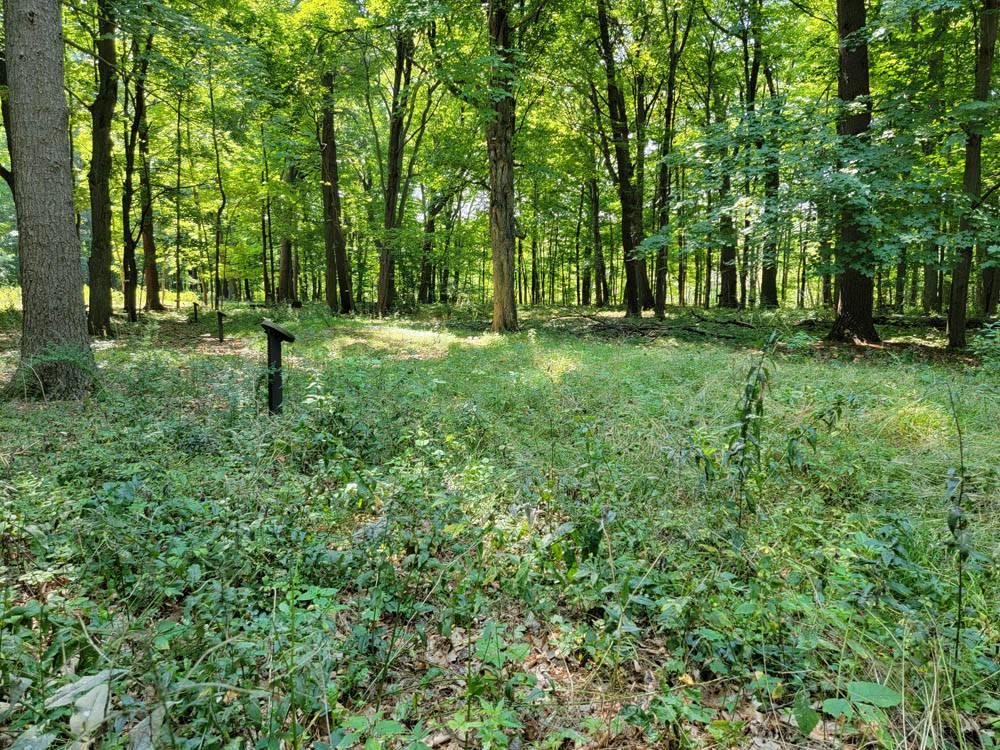
My introduction to Sheboygan began with residents from a millennium ago. Sheboygan Indian Mound Park is a small wooded area that preserves a sacred burial ground. It’s a site of archaeological significance, and it was saved by a couple of garden clubs.
Between 500 and 1000 AD, Effigy Mound Builders lived primarily in southern Wisconsin, as well as neighboring sections of Minnesota, Iowa, and Illinois. They honored their dead by burying them in mounds, many of them shaped like animals, or effigies.
In 1922, Adam Kletzien discovered 34 mounds on his property. Five years later, Milwaukee Public Museum excavated 26 of them for study. Then in 1958, Town and Country Garden Club, co-founded two years earlier by Julilly H. Kohler (of the Kohlers – you’ll be hearing a lot about them), and Juniper Garden Club learned that the land was to be sold to a residential developer.
If that happened, the mounds would be destroyed like so many others had been. In only four months, these garden clubs raised the $15,362 dollars needed to buy the land, and in 1966 it was dedicated by the City of Sheboygan as an archaeological park.
Sheboygan Indian Mound Park was declared a Wisconsin Historic Site in 1968, a Sheboygan County Landmark in 1977, and in 1981 the Kletzien Mound Group was added to the National Register of Historic Places.
There are interpretive signs at the entrance, and a map shows the location of the mounds as well as a nature trail. Signs at each mound explain the shape: panther, deer, fawn, linear, or conical. The signs are necessary. Trees erupt from the mounds themselves, which is to be expected since they’ve been there for about a thousand years.
Related: Sheboygan is one of the best road trips from Chicago.
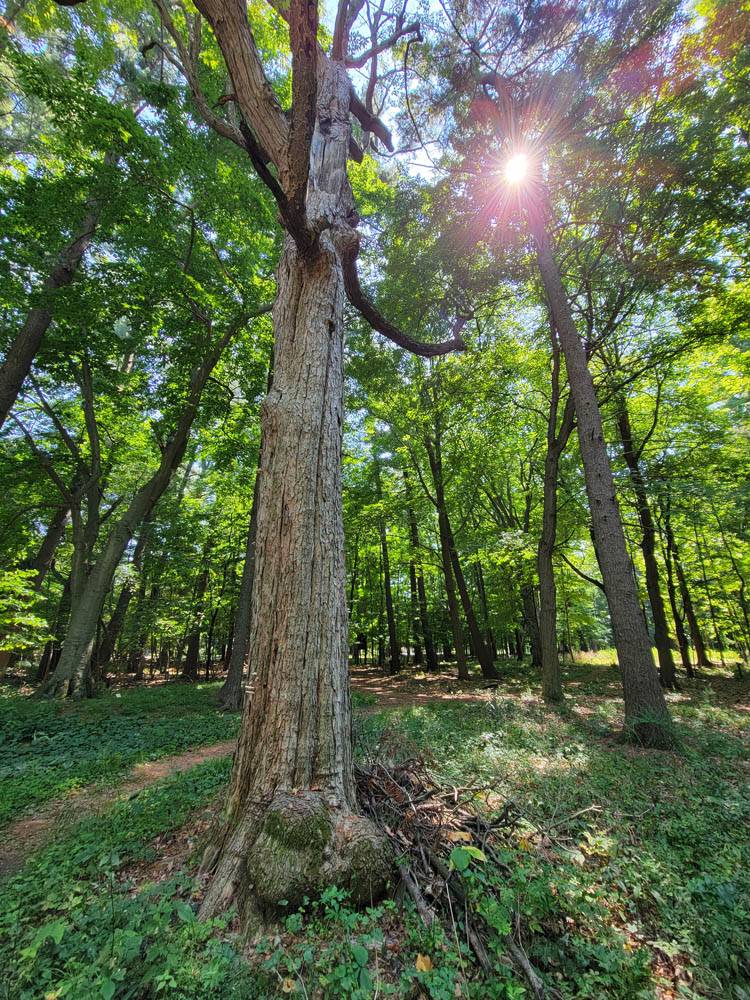
I was able to walk much of the grounds despite downed trees blocking a path due to a recent storm. Because of the overgrowth, I couldn’t see the mounds’ shapes, although it was obvious these weren’t natural formations.
It was also obvious what would have happened had the garden clubs not stepped in: a stockpile of firewood marked the border between the park and someone’s backyard, which was a short distance from a panther sculpted out of earth.
A mile and a half from the mounds was another woodland treasure. I ignored GPS because it looked like it was directing me to someone’s house, so I missed the small sign marking the entrance to the James Tellen Woodland Sculpture Garden.
I realized my mistake once I saw a fence made of concrete, and a concrete bear and her cubs perched atop a concrete hollow tree.
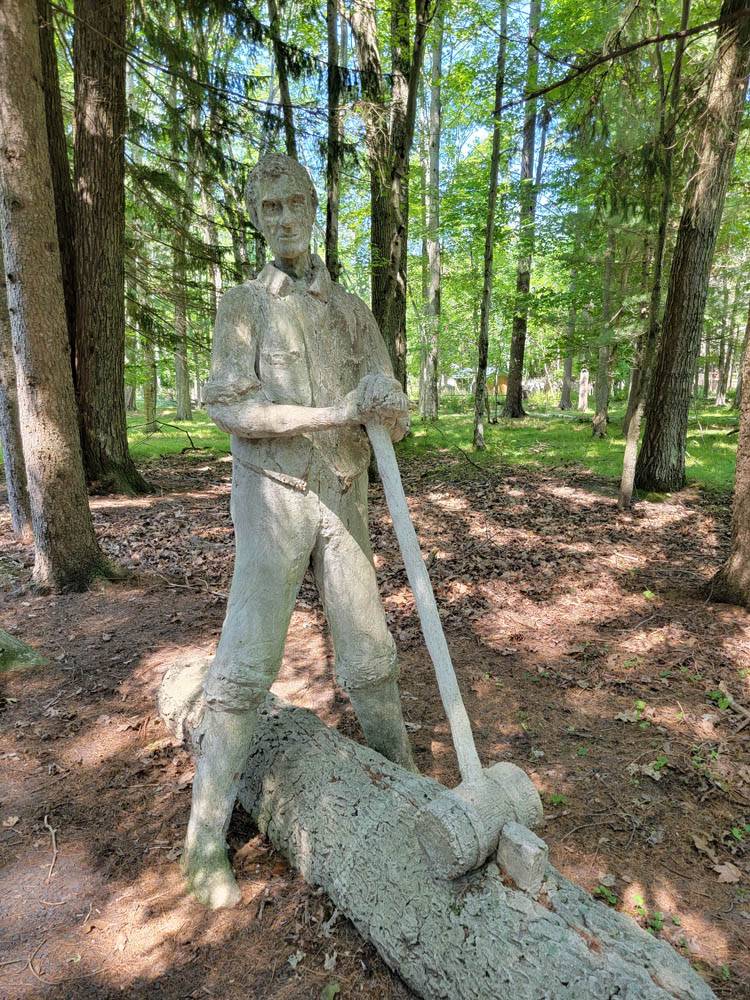
Between 1942 and 1957, James Tellen, a former striper, or detailer, at the Northern Furniture Company, created scenes and installed them along a winding path near his family’s summer log cabin. Some of the sculptures depict pioneer life; there’s a tavern scene, a mill, and Abraham Lincoln resting after chopping wood.
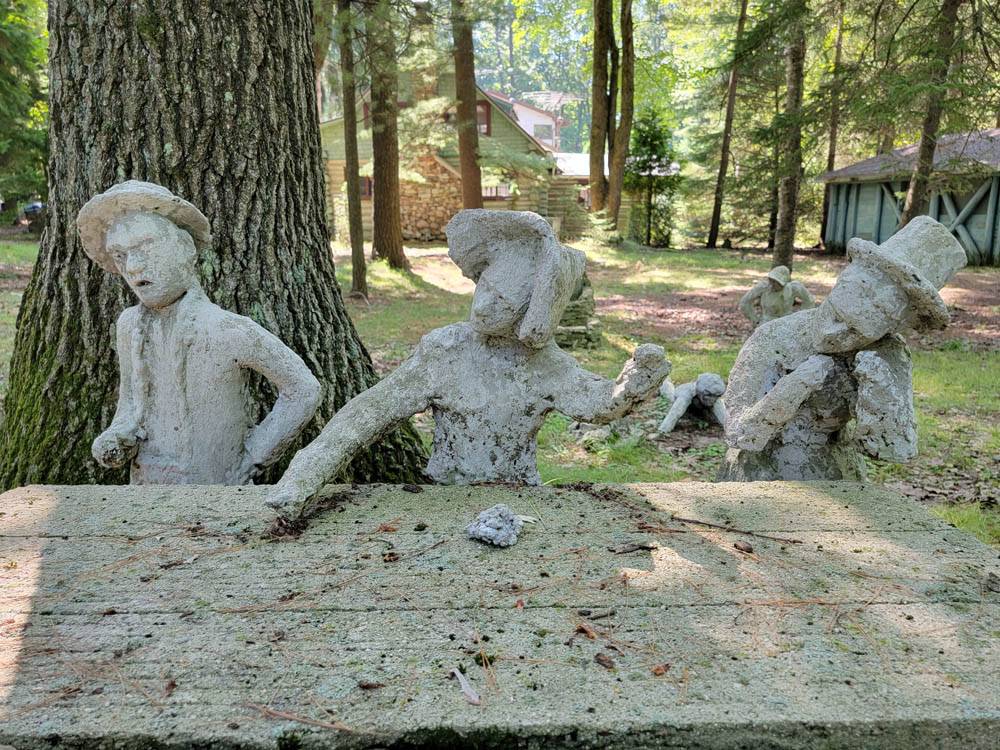
Others are mythical: a tree with elves, the seven dwarves whistling while they work. Tellen was a devout Catholic and many are religious in nature, including a cathedral, the Virgin of Fatima, and Christ. It’s an enchanting stroll.
The garden is conserved by the Kohler Foundation and was donated to the John Michael Kohler Arts Center in 2000.
I’d only stopped at two places, and at both had encountered the Kohler family. I’d experience their influence often over the next two days.
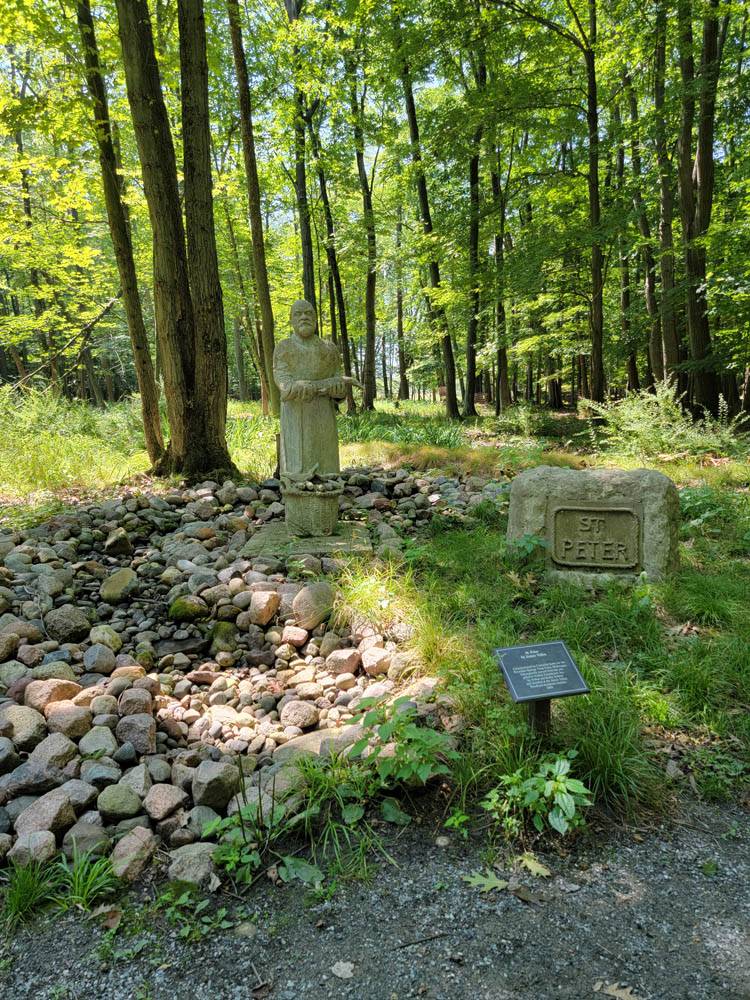
My tour “officially” began when I met Visit Sheboygan’s Public Relations Director Shelly Harms at the visitor center.
I’ve been to a lot of visitor centers. Taking advantage of these resources is advice I give and follow. They’re wonderful places staffed with people who love to show off their homes.
However, I have never seen a visitor center like Visit Sheboygan. Most are essentially libraries of travel brochures. You stop in, browse the racks, and ask the person behind the counter for recommendations. You can often buy some branded merchandise.
You can do that at Visit Sheboygan. You can also buy items made by local artists. But this new facility, which opened in October 2020 after pandemic delays, is more like a community center.
There are plans to take advantage of their location on the Sheboygan River and create “Science in the Sky,” a “project featuring an off-the-grid 90-foot raised platform cantilevered 30 feet over the Sheboygan River with a self-contained eco-system of the Lake Michigan land- and water-scape including freshwater aquaponics and plant life.”
There’s science inside, too, including a lab that can be used by local school groups. But what’s really cool is Science on a Sphere, a suspended globe that acts as a projector screen. The National Oceanic and Atmospheric Administration (NOAA) has made hundreds of programs available to them, including the solar system and asteroid belt, but also showing how tectonic plates have shifted and the shrinking of rainforests.
The visitor center also has Meisfeld’s summer sausage, which I stocked up on for a romantic getaway in Sheboygan.
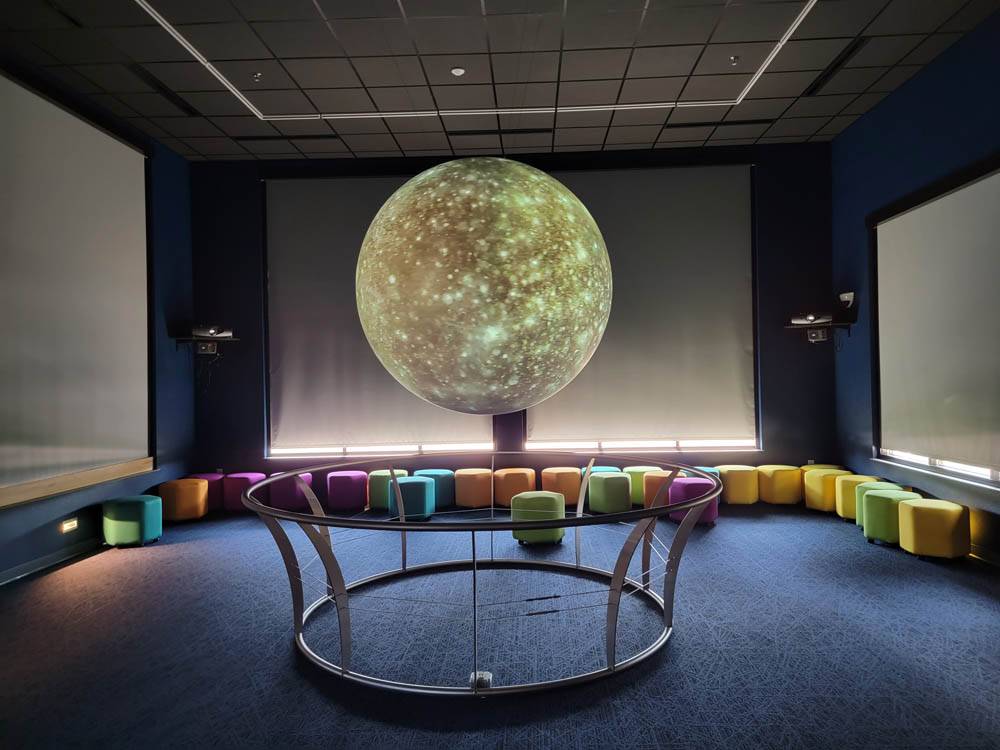
I would have enjoyed hanging out and watching some of those programs, but brats and a beer were calling my name.
Sheboygan is the Bratwurst Capital of the World. It’s official. In 1979 they won a competition with Bacyrus, Ohio, and they’ve claimed the title ever since.
A Sheboygan brat is unique. It’s fried. (It’s not really fried; that’s just what they call it.) It is never ever boiled. You get two and they’re served on a round hard roll that most likely comes from City Bakery. The only acceptable toppings are raw onion and ground mustard. If you get the brat plate, it’s served with American potato salad and baked beans. Not syrupy baked beans. Theirs are almost like a stew.
Go five miles out of town and your brat will be served on an elongated bun, just like anywhere else. It will also be grilled. There might even be (ick) sauerkraut on it.
Do any of that in Sheboygan and you’re liable to be asked to take your mess and go, thank you very much. (Doubt me? They’ve got a Brat Pledge, for hard roll’s sake.)
I was introduced to the winning presentation at Sly’s Midtown Saloon & Grill, which was exactly what you picture a Wisconsin dive bar should be. I paired my traditional brat plate with a Spotted Cow, because when in Wisconsin you order a beer that you can only get in that state.
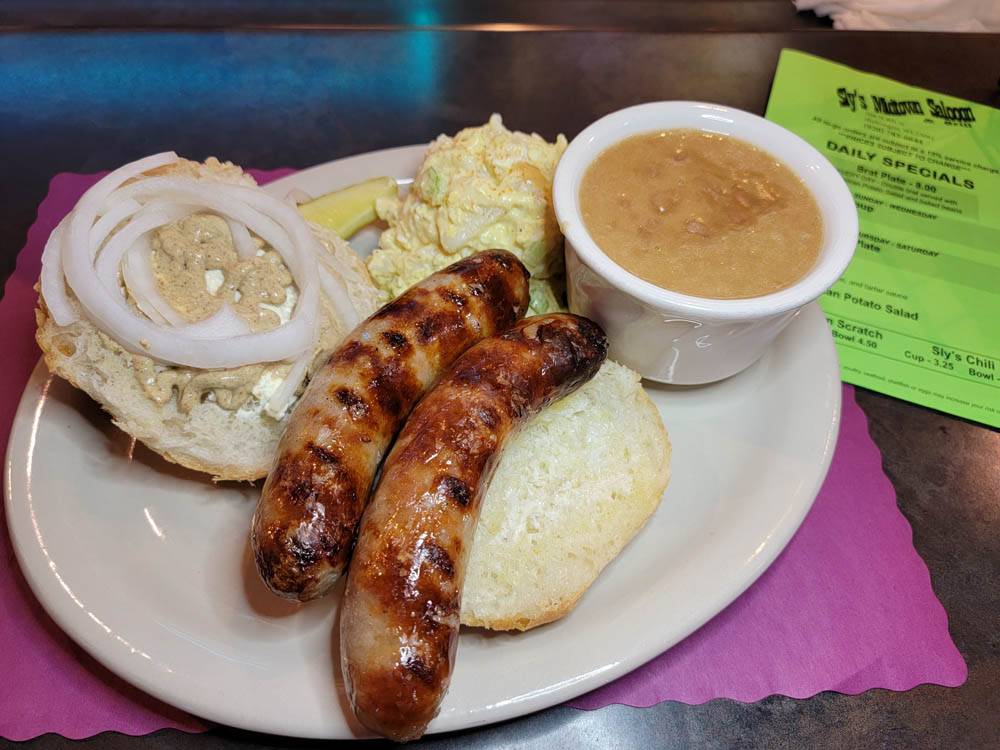
The bartender told me I’d need a box. I didn’t.
I should have.
But I didn’t.
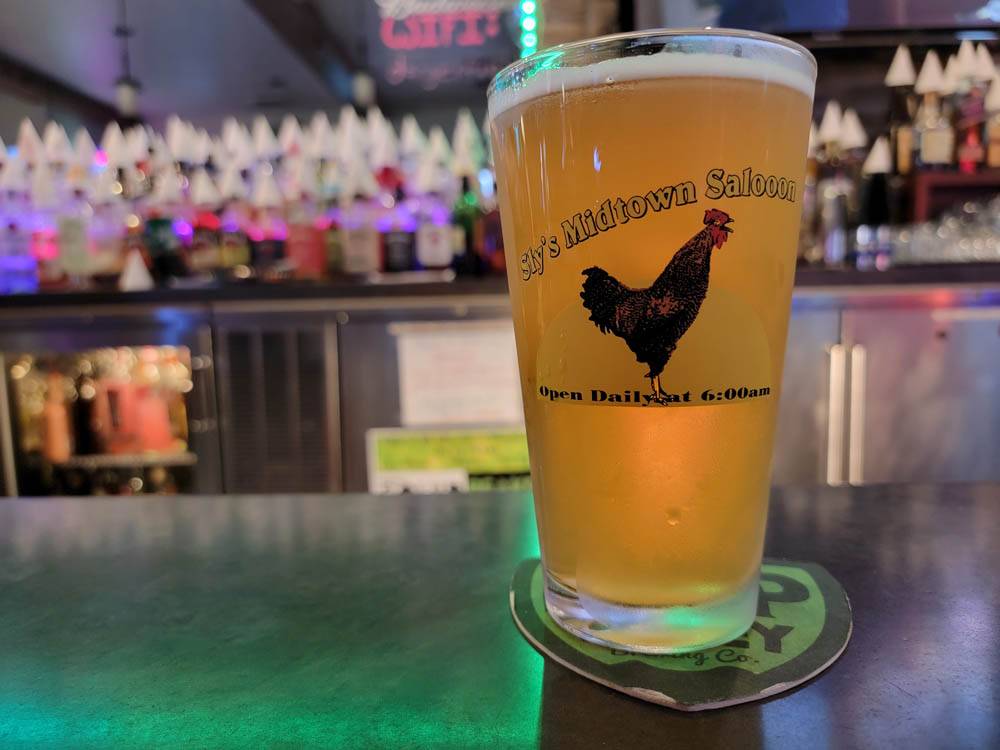
After that proper introduction to Sheboygan, a tour of the historical museum put the rest of my exploration in perspective.
Overlooking an old Native American trail on the highest point in the city, the Sheboygan County Historical Society and Museum is a complex that includes a modern building as well as historic structures that represent the town’s past. There’s a 20,000-square-foot building that houses exhibits, a log cabin from 1864, a cheese factory (because, Wisconsin) from 1867, and an 1890s barn.
The centerpiece is a two-story Italianate-style mansion made out of cream city brick. Built by Judge David Taylor in the early 1850s, it’s seen a few uses in the past 170 years, including a twenty-six-year stint as a Sheboygan County Chronic Insane Asylum work farm. It was even a temporary jail for a short time during the Great Depression.
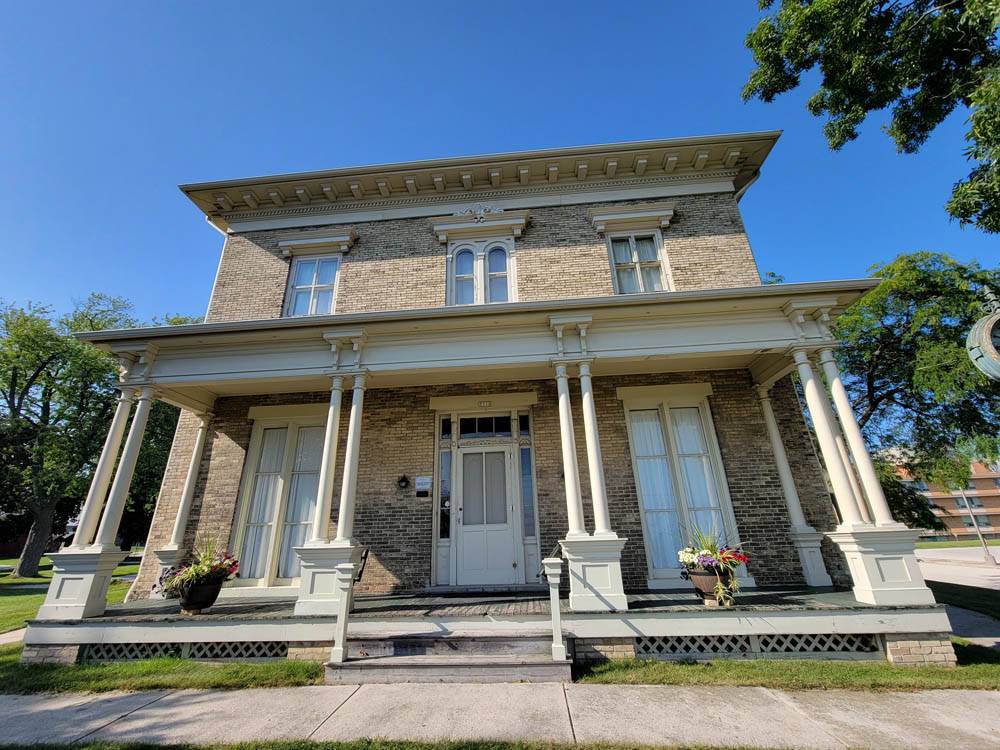
In 1952, the Sheboygan County Historical Society moved in. For many years the mansion served as the primary exhibition space. Today the rooms are decorated to recreate what they might have looked like during Judge Taylor’s time.
Executive Director Travis Gross provided a thorough tour, beginning with “The Way We Worked,” a traveling exhibit from the Smithsonian that will be at the museum through October 9. Originally slated for 2020, the exhibit details the history of labor and includes all types of work, not just manufacturing.
We then browsed the permanent exhibits. They begin with the area’s original inhabitants, including a display discussing those mounds I’d visited and a wigwam crafted in the traditional manner. Then it progresses through the early settlers, showing the types of agricultural equipment they would have used.
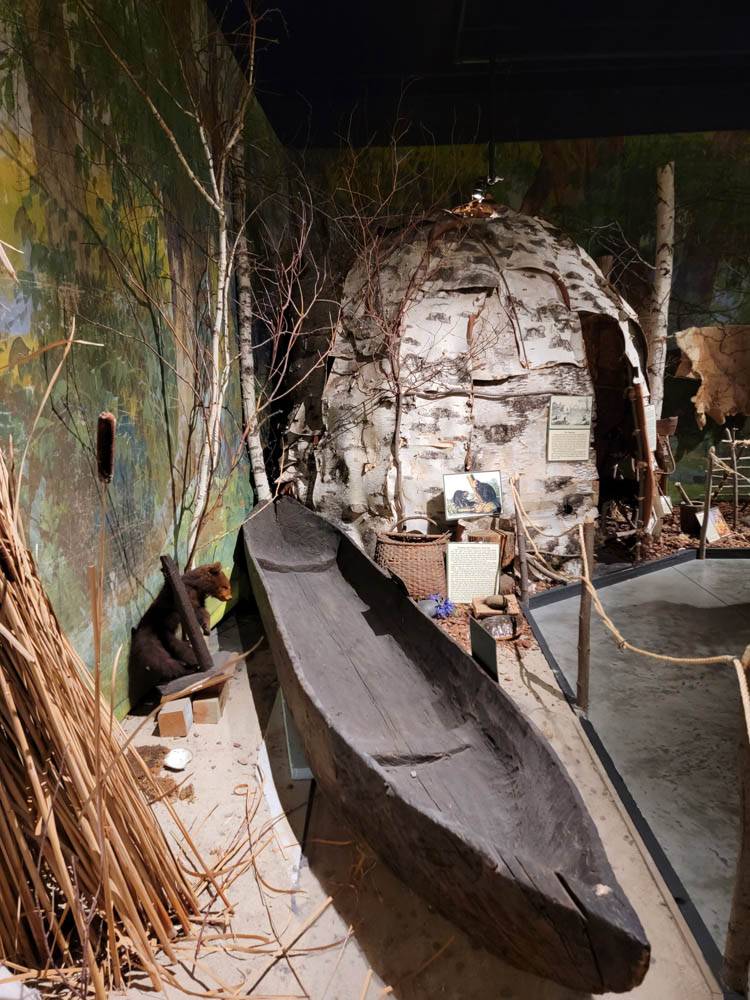
With its natural harbor, at first it looked like Sheboygan would be a boomtown, but then the panic of 1832 put the kibosh on that. Travis told us how the founder of Sheboygan, William Farnsworth, constructed multiple buildings so that passing ships would think it was busy when in reality only three families lived there at the time.
The town did grow and enterprising businessmen dug a channel, dumping the excavation to the north. As we traveled through Sheboygan’s past, I was struck by the parallels to Chicago’s growth: reclaimed land, a straightened river, a dredged harbor.
I learned that in the 1890s, millions of chairs shipped out of Chair City. That almost every chair company ended in fire, including one named Phoenix. That Sheboygan was known as the City of Three Cs – Chairs, Cheese, and Children, and later added a fourth, Churches. That the circus was a big deal and one of the original NBA teams was here, only to be kicked out after a year because New York and Boston didn’t want to play with those “rubes.”
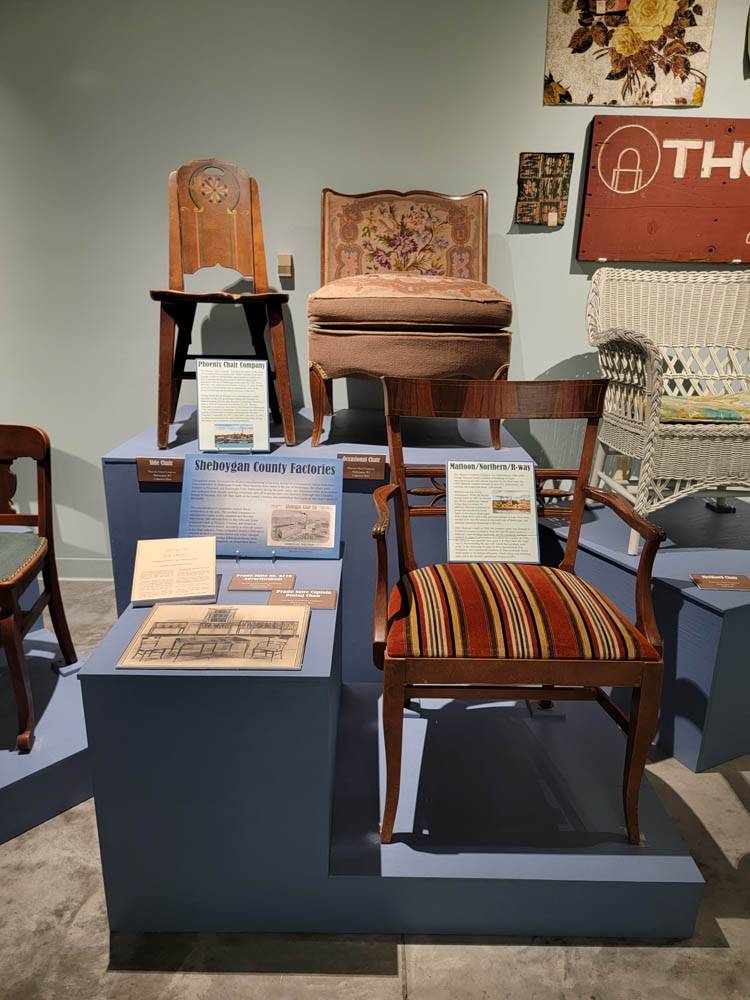
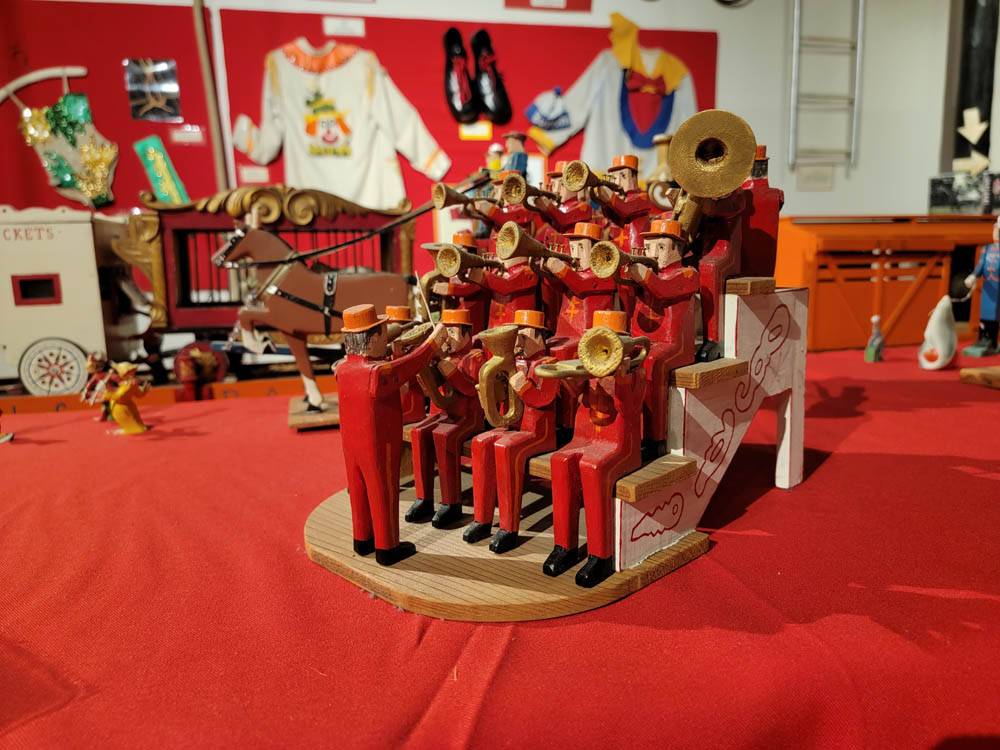
I learned my accommodations, the lovely Blue Harbor Resort, sits on what had been a place where coal was stored. I learned about fish shanties, so when I ate in one two days later, I had a sense of time and place.
This was a perfect example of why I recommend visiting local history museums. They provide context.
Down the hill from the museum is the Sheboygan County Veterans Memorial. Dedicated in 1994, it honors Sheboygan County men and women who gave their lives or participated in the many wars fought by the United States. Out of the original 767 names inscribed on the black granite pillars, more than half of them died in the Civil War.
Since its dedication, a Gold Star Memorial and a marble wall with room for more names has been added. Honorees are engraved on the second Saturday in October. To add a name, they request a contribution of $150.
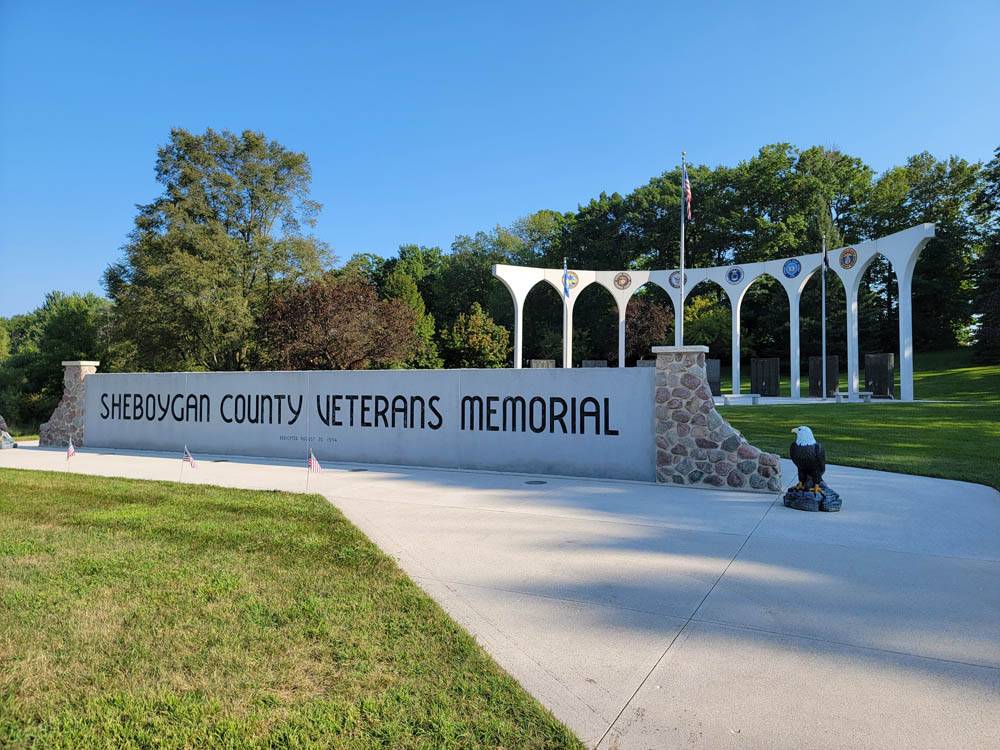
After that somber visit, I checked into Blue Harbor Resort and had just enough time to freshen up and ogle the view of Lake Michigan before Shelly picked me up.
Our destination: City Green, an arts and entertainment green space, for the Night Market.
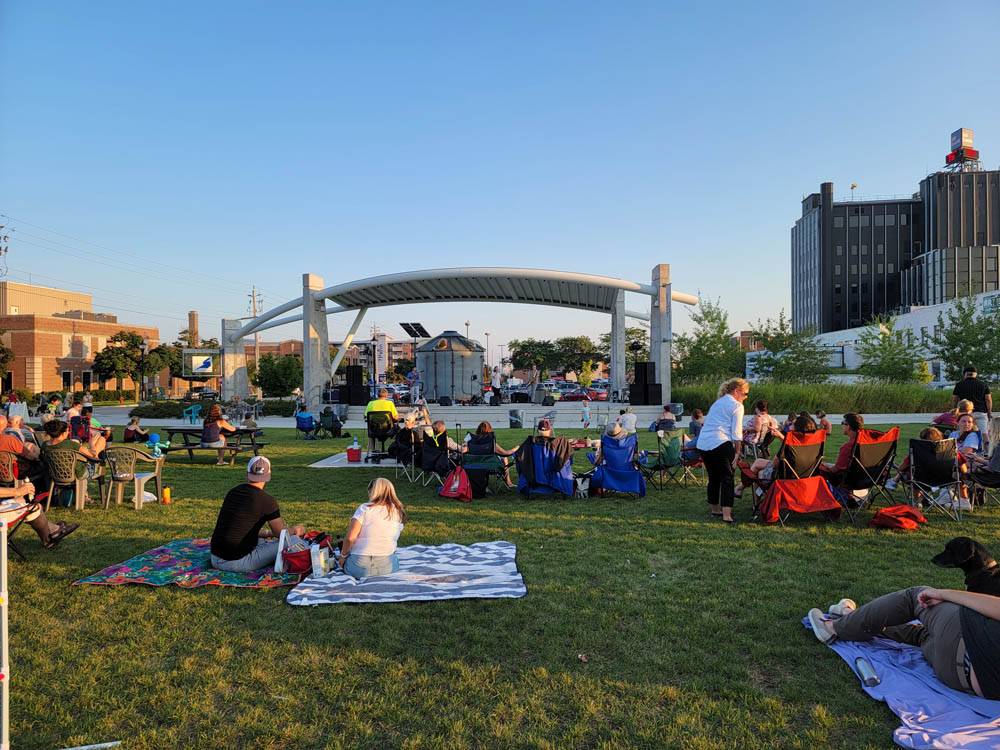
It was a perfect, balmy evening. A woman made balloon animals, children roasted marshmallows, a band played.
Vendors set up along 8th Street, including my friend Lori of Lori Loves Adventure and her beautiful Beatrice. Beatrice is a vintage camper that Lori and her husband rescued and restored, and she’s written two children’s books about her. They’re charming, just like Lori and just like the Paris-inspired decor that Beatrice is decked out in.

Food trucks tempted us, but we decided to go to Black Pig, a farm-to-table restaurant that loves its pork.
We made the right choice.
Dinner began with an Oat Fashioned, a twist on the Wisconsin staple made with Corsair Oatrage Whiskey, cherry and hazelnut liqueurs, orange bitters, and house-made maple whiskey, and garnished with peppered bacon. We then dug into their beef carpaccio. Their rendition included white truffle crema, fried capers, arugula, and Sartori Black Pepper Bellavitano.

Do I need to say it was delicious?
It was, but our entrees had us swooning. Fennel and rosemary-crusted Berkshire pork crowned rich portobello ravioli, pancetta, pearl onion, sweet corn, and black truffle butter.
I ate every. single. bit.
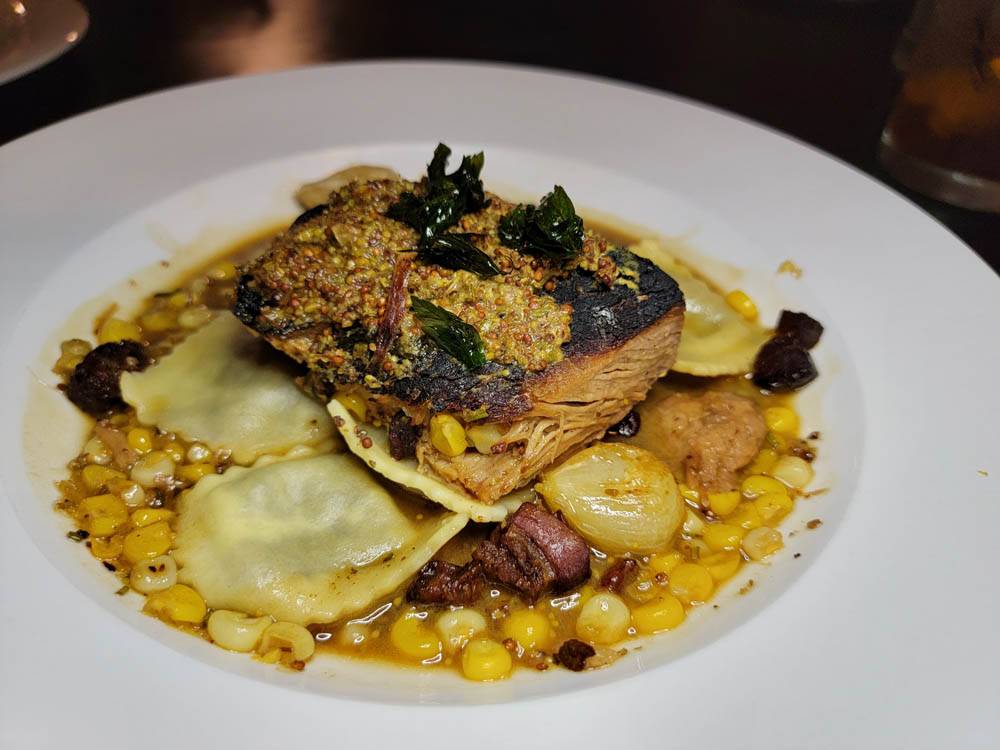
The subtle sounds of a calm Lake Michigan greeted me the next morning, and while I would have been perfectly satisfied to spend the day at the resort, Shelly, Lori, and I had a full day planned.
We began at Paradigm, a delectably charming coffee shop and bakery. This is a place where everyone is welcome-except bigots and racists. The first indication of their inclusivity could be the proudly waving Pride flag, but in case that’s not clear, there’s a sign.

With the exception of a few items, owner Kate Krause and her team source from local producers. There are vegan, vegetarian, and gluten-free selections in addition to their baked goods. I opted for the bagel sandwich and I decided that Kate et al must be magic. With sharp cheddar, egg, and garlic mayo, it might seem simple, but it was the best bagel sandwich I’ve ever had.

After a stroll admiring the public art and browsing the farmers market, we headed to the lake. The next few hours would be dedicated to experiencing the Malibu part of this Malibu of the Midwest.
Sandy beaches and a limitless horizon give the Sheboygan coast the feeling of a tropical getaway. It’s a favorite winter surfing spot and is popular for wind- and kitesurfing.
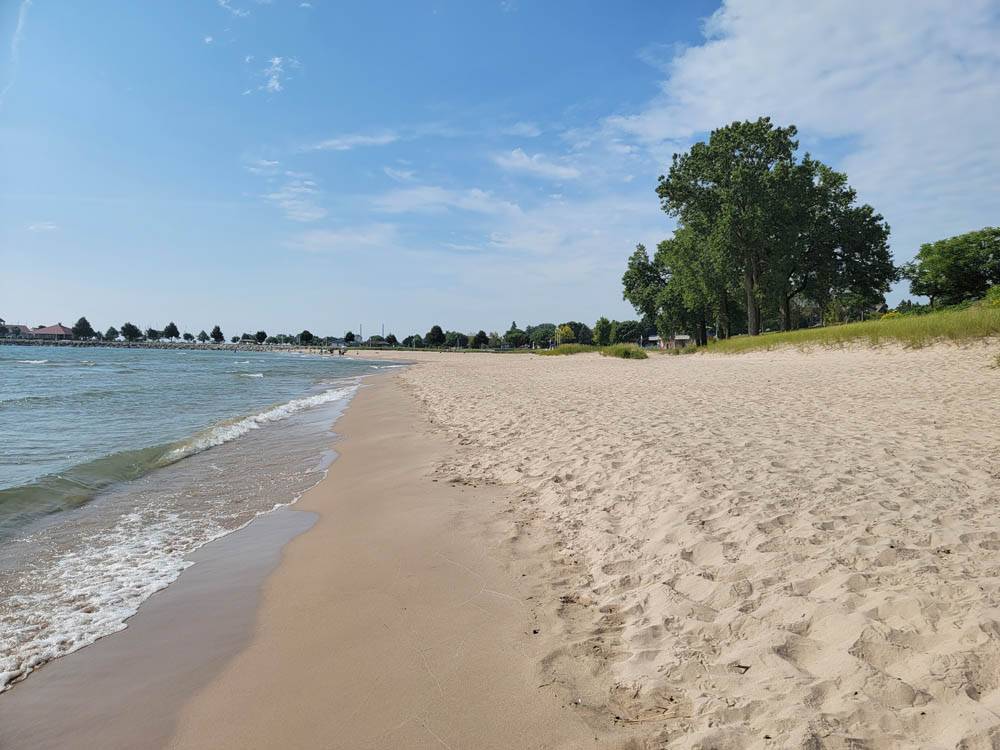
The shape of the shore along North Beach also makes it a prime spot for beach glass, and while I came up empty, I did find a treasure at our next stop.
The Lottie Cooper, a three-masted schooner, sank in 1894 and remained buried and forgotten until she was discovered during the 1992 construction of the marina. The recovered portion of her hull is on display in Deland Park.
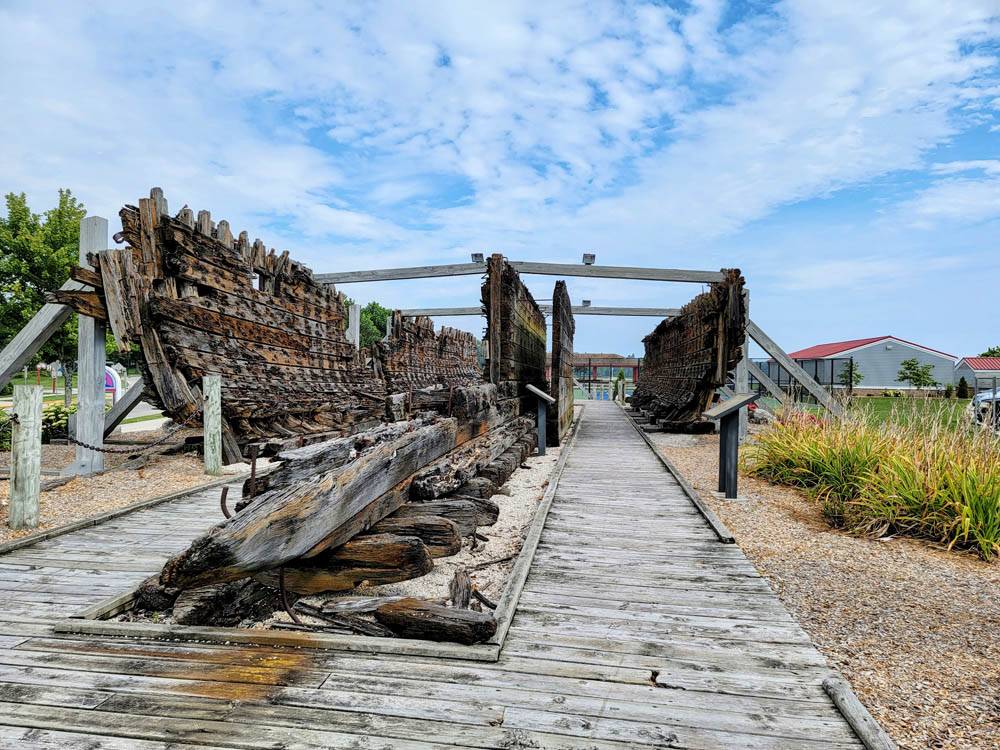
Because it’s open to the elements, the wood continues to decay and there are concerns that it will disintegrate completely without protection. Marveling at the size and imagining what she must have looked like in her glory days, I found a rock painted with a red, white, and blue ice cream cone tucked in her timbers. “Sheboygan rocks Facebook” was painted on the back. Locals paint rocks and leave them around town for people to find, keep, or rehide. I took my find with me, knowing that I’ll have to return so I can replace it with one I create.
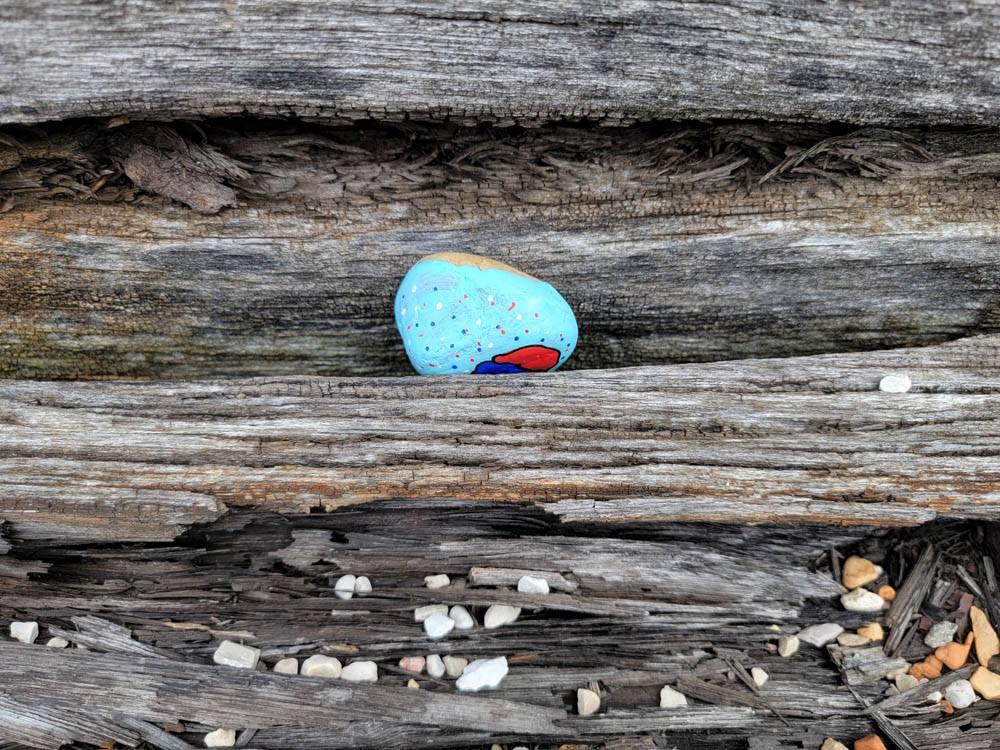
“I’m really glad you told us this can’t tip over.”
At this point, I’d been steering a sailboat for about twenty minutes and was completely out of my comfort zone. I’ve been on a few sailboats, not many, but I was always far away from any controls and usually had a cocktail in hand. I’d never put my hand on a tiller, hoisted a sail, tacked, or navigated with the aid of tell tales and a point on the horizon.
Now I’ve done all of that, thanks to Matt Wierzbach, Program Director of Sailing Education Association of Sheboygan, or SEAS.
Lori and I got our feet wet, so to speak, with the non-profit organization’s First Sail Experience. Lesson One, Matt said, was that the keel of the boat weighs nine-hundred pounds and there was no way we could tip over. Definitely good to know as the sun hid and the winds picked up, pushing us at such an angle we had to brace ourselves.
It was slightly intimidating, a bit nerve-wracking, and a complete blast, and I would totally do it again.
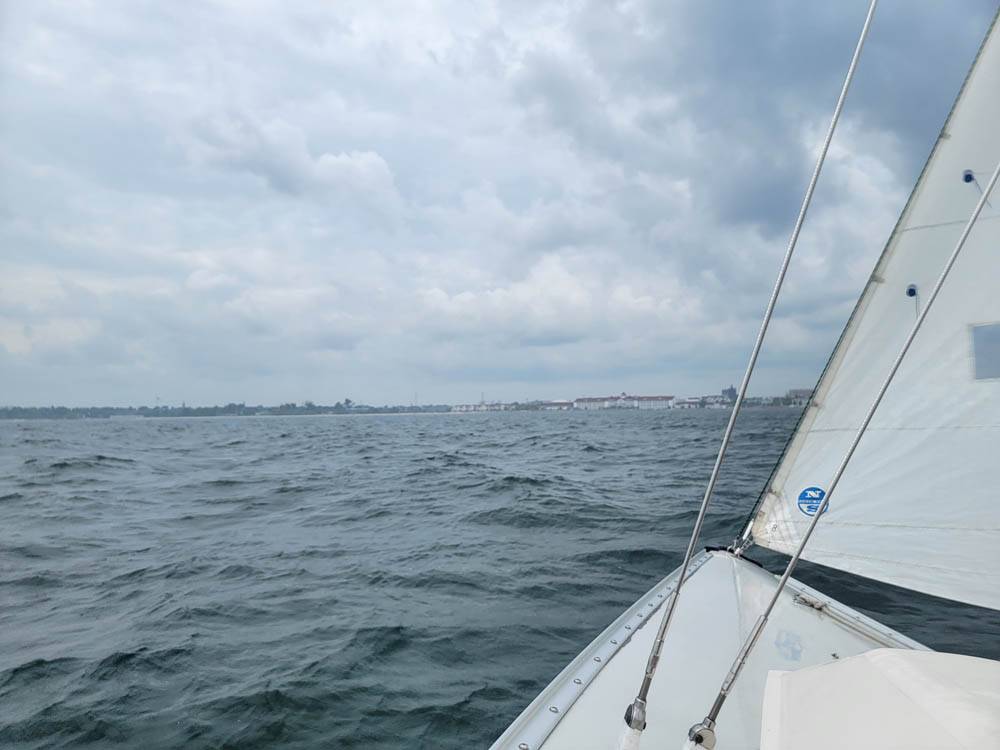

Anybody can sign up to take this two-hour class, perfect for a unique experience during a weekend getaway to Sheboygan. SEAS also offers Basic Keelboat lessons if you want more extensive instruction.
One of the most exciting aspects of SEAS is that they believe sailing should be available to everyone. They offer adaptive sailing lessons for those with limited mobility, as well as for the visually impaired. If you already know how to sail, you can get a membership and rent sailboats. Their goal is to grow the sailing community.
SEAS also works with other lakeside communities and the NOAA to preserve shipwrecks and encourage heritage tourism. Officially designated on August 16, 2021, the Wisconsin Shipwreck Coast National Marine Sanctuary covers 962 square miles and protects 36 known shipwrecks from Port Washington to north of Two Rivers.
By the time we docked and rolled up the sails, we were ready for some pizza. And not just any pizza. VPN certified Neapolitan pizza, baked in a special wood-fired oven that came directly from Italy.
We weren’t the only ones who thought a slice or twelve at Il Ritrovo sounded good, so while we waited for a table we wandered down the street to Olivü 426, a shop offering skin, hair, and home products made from olive oil and other natural ingredients. Caitlin Brotz began making lotions in 2003 when her boyfriend suffered severe burns and could not use store-bought lip balm, or lotion that contained alcohol. Although he healed, in 2005 he died in a car accident. Caitlin opened her store the next year in honor of him.
Since I’d recently finished radiation treatments, I appreciated these all-natural products and picked up a few. One thing I really like is that you can choose to add your own essential oil fragrance. You can also order online.

We had just enough time to pop into Victorian Chocolate Shoppe and snag some truffles before our table was ready. Its building had once been a trolley station and a bus depot. Now owners Joel and Peggy Tauschek tempt you with vintage candy and homemade chocolates.
Our lunch at Il Ritrovo started with a special of prosciutto, peaches, and mozzarella and crusty bread. Then it was time for the pizza. We chose Boscaiola, with mozzarella, truffle cheese, smoked mozzarella, rosemary, pancetta, and roasted mixed mushrooms. Doesn’t that sound divine?


It was. As was the Prosciutto Crudo e Ruchetta, a simpler pie with tomato, mozzarella, parmigiano, prosciutto di Parma, and arugula.
There weren’t any leftovers from this meal, either.

The John Michael Kohler Art Preserve is the first of its kind. An extension of the Kohler Arts Center, it’s designed to preserve environments that artists have created, whether these artists are self-taught or have received training.
Without realizing it, I’d seen an example of this type of environment the day before at the James Tellen Woodland Sculpture Garden. Tellen had created an entire world, populating his property with his art.
The Art Preserve is the realized vision of Arts Center Director Ruth DeYoung Kohler II, who died in November 2020. After what she called “the most astonishing and moving experience” she’d ever had at the home of artist Eugene Von Bruenchenhein, the Arts Center acquired six thousand of the artist’s objects. It was their first en masse purchase of an artist’s body of work in an attempt to preserve its unique milieu.
The Art Preserve opened in the summer of 2021 with thirty-five of these environments, including Von Bruenchenhein’s sculptures made of chicken bones; Emery Blagdon’s The Healing Machine; and selections from The Rock Garden of Chandigarh, created in India by Nek Chand.



To explore this 56,000 square foot space is to get a sense of the astonishment that Ruth felt. It’s almost overwhelming to see the sheer volume of works in these collections. Don’t expect to pop into the bathrooms for a reprieve from the sensory input. These, too, are artist-built environments.

We left this massive shrine to creativity to visit a massive symbol of freedom. The Acuity Flag is the world’s largest free-flying American flag, soaring atop the tallest flagpole in North America. At its base the names of Sheboygan County veterans killed in the line of duty are inscribed in pavers. A brochure available on-site lists the location of each name.

3 Sheeps Brewing, our next stop, is a perfect example of American entrepreneurship.
In 1926, during the middle of prohibition, Grant Pauly’s great grandparents bought a failing brewery, which had been founded in 1847. They renamed it Kingsbury and expanded nationally. Grant grew up hearing his father’s stories about the brewery, and after his wife got him a home brewing kit he was bit by the beer bug and dreamed of owning one himself.
That dream became 3 Sheeps Brewing, a play on “three sheets to the wind.” It opened in 2012 and RateBeer named it the Best New Brewery in Wisconsin. Since then it’s grown tremendously and now occupies a 40,000 square foot facility that had previously been a Coca-Cola distribution plant.
Their philosophy is to create beers that are both unique and drinkable. No over-the-top hops just because they can, no insanely high gravity because that’s what’s hot. They take a methodical, research-based approach and it’s worked.
Grant and his team share their success. Bourbon barrels used for aging can be hard to come by, but because 3 Sheeps has the second or third largest barrel program, they don’t have a problem. When they do get barrels in, they often get a few extra for smaller breweries that don’t have the buying power.
I’m a fan of 3 Sheeps and have featured them at a few of my AlphaBeer events. We tried a colorful flight, including a juicy pale ale, a hazy IPA, a slushie-style beer, a milkshake IPA, and Cashmere Hammer, a nitro stout that’s one of my favorite beers ever.
We also tried their just-released The Wolf with coffee from JBC Roasters, an imperial stout that had been aged in one of those barrels. I’ve had lots of high gravity beers in my time and they often taste like it. This one, despite an ABV of 12.3%, was eminently quaffable.
A wolf in sheep’s clothing, if you will.
(I can’t take credit for that turn of phrase. It’s on their website.)


Dinner was around the corner at BoMallies, a delightfully quirky fusion restaurant with the feel of a throwback supper club. We entered through an arch flanked by lush trees to a secluded patio. The dimly lit interior is small and there are only a few tables, providing a sense of exclusive intimacy.
The menu is a hodge-podge of “Hey, that sounds good!”, like pork and shrimp potstickers, bread and pesto, and crepes filled with spinach, tomatoes, and roasted mushrooms with basil aioli. The potato bravas were a pile of savory with chorizo, manchego, scallions, roasted garlic aioli, and topped with a duck egg.



BoMallies began as a food truck and opened the restaurant in 2017. They’re open Wednesdays through Saturdays and will often have magic shows. You can check their Facebook page for upcoming events.

By the time we finished our decadent dessert and left BoMallies, full and sated, it was after 9:30. Since I had a big room with two queen beds and a bottle of wine in the mini-fridge, I invited Lori to stay for a sleepover. We two gals popped that wine and sat on the balcony, chatting and watching the moon shimmer over the lake for hours. It was a lovely end to a lively day.
I was up before the sun the next morning so I could watch it awaken. We then walked down to the beach and stuck our feet in the surf before heading over to Weather Center Cafe for breakfast.

Weather Center is located in one of those original fishing shanties I’d learned about at Sheboygan County Historical Society and Museum. The windows in the front are practically at street level because the sidewalk was built up around it.

The Cafe is run by surfers and definitely has that laid-back vibe. We got there a little early and waited with several others for their doors to open, then took our breakfast outside to soak up the sun along the Sheboygan River.
After taking Lori back to her car, I spent one more spell on the balcony, watching the kitesurfers and listening to the families playing in the pool below. It was hard to believe my time in Sheboygan was coming to an end, but I had a date in Door County.

I wasn’t quite done with the Malibu of the Midwest, though. On my way back home three days later, I made a couple more stops. The first was to Meisfeld’s, a family-owned meat market that’s been around since 1941, to pick up some sausage to go with all the Door County cheese I was bringing home.
The second, and final stop in my Sheboygan tour was to the John Michael Kohler Arts Center. After experiencing the Art Preserve, and seeing how much the Kohler Foundation had done for Sheboygan, including the public art displayed on 8th Street, I had to see this renowned facility.

The Arts Center is a contemporary art museum whose mission is “to generate a creative exchange between artists and the public.” It does this from the artist-designed bathrooms to the exhibits focusing on self-taught artists. I was particularly moved by the gallery celebrating Ruth DeYoung Kohler II. Her beliefs in inclusivity, diversity, and that arts could bring positive social change have left a profound impact on Sheboygan, Wisconsin, and the arts world as a whole.


Sheboygan definitely had a profound impact on me. I arrived curious and left enchanted, wondering when I can return to Chair City and sit awhile.
Sheboygan. Who knew?
3-Day Sheboygan Itinerary
Would you like to discover Sheboygan for yourself? Here’s my itinerary:
Sheboygan Itinerary, Day 1
- Sheboygan Indian Mound Park
- James Tellen Woodland Sculpture Garden, 5634 Evergreen Dr, Sheboygan, WI 53081
- Visit Sheboygan Visitor Center, 826 S 8th St, Sheboygan, WI 53081
- Sly’s Midtown Saloon and Grill, 508 N 8th St, Sheboygan, WI 53081, slysbarandgrill.com
- Sheboygan County Historical Society and Museum, 3110 Erie Ave, Sheboygan, WI 53081, sheboyganmuseum.org
- City Green, New York Ave and 7th St., Sheboygan, WI
- Black Pig, 821 N 8th St, Sheboygan, WI 53081, eatblackpig.com
Sheboygan Itinerary, Day 2
- Paradigm Coffee and Music, 1202 N 8th St, Sheboygan, WI 53081, paradigmvenue.com
- Sheboygan Farmers Market, Fountain Park, Sheboygan, WI, sheboygancountyinterfaith.org
- Deland Park, sheboygandpw.com
- Lottie Cooper, wisconsinshipwrecks.org
- SEAS, 619 Broughton Dr, Sheboygan, WI 53081, seasheboygan.org
- Olivü 426, 502 N 8th St, Sheboygan, WI 53081, olivu426.com
- Victorian Chocolate Shoppe, 519 S 8th St, Sheboygan, WI 53081, victorianchocolateshoppe.com
- Il Ritrovo, 515 S 8th St, Sheboygan, WI 53081, ilritrovopizza.com
- John Michael Kohler Art Preserve, 3636 Lower Falls Rd, Sheboygan, WI 53081, jmkac.org
- Acuity Flag, 2800 S Taylor Dr, Sheboygan, WI 53081, acuity.com
- 3 Sheeps Brewing Co., 1837 North Ave, Sheboygan, WI 53083, 3sheepsbrewing.com
- BoMallies, 2427 Calumet Dr, Sheboygan, WI 53083, bomallies.com
Sheboygan Itinerary, Day 3
- Blue Harbor Resort, 725 Blue Harbor Dr, Sheboygan, WI 53081, blueharborresort.com
- Weather Center Cafe, 809 Riverfront Dr, Sheboygan, WI 53081, facebook
- John Michael Kohler Arts Center, 608 New York Ave, Sheboygan, WI 53081, jmkac.org
Sheboygan Map
Here’s a map of everywhere I visited during my time in Sheboygan.
